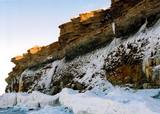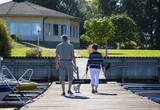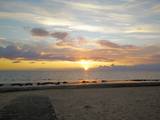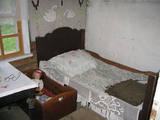| Nr | Name | Beschreibung |
|---|---|---|
|
Die mächtigste Steilküste im Baltikum (bis zu 24 m hoch). In den kalten Winter werden hier phantastische Gletscherstürze entstanden. Pakri Leuchtturm. |
||
|
Saimniecība “Lejaskroķi” atrodas Abavas senlejā. Tajā nodarbojas ar truškopību. Saimnieku aprūpē ir ap 500 trušu, kā arī kazas un mājputni. Viesojoties saimniecībā, viesi varēs samīļot un pabarot trusīšus, kā arī apskatīt kazlēnus, kam ļoti patīk cilvēku uzmanība. Dzīvnieciņus iespējams apskatīt, iepazīt un samīļot, kā arī pabarot. |
||
|
Tūrisma gide Ineta Jansone piedāvā ekskursijas grupām uz Ķemeriem un iepazīstina ar Ķemeru kūrorta vēsturi. Kopš seniem laikiem Ķemeri slaveni ar to, ka šeit ir daudz sērūdeņu avotu un ārstnieciskās dūņas. Šurp brauca ārstēties kopš 19. gs. sākuma. 1838. gadā Ķemeros nodibināja kūrortu. Ķemeru kūrortā ārstēja ādas un kaulu slimības, kā arī gremošanas un nervu sistēmas slimības. 1877.g. izbūvēja dzelzceļa līniju Rīga - Tukums, bet 20.gs. sākumā tika ieviesta tiešā dzelzceļa satiksme ar Maskavu. Kūrorts bija ļoti populārs un katru gadu arvien vairāk viesu brauca šurp ārstēties. Īsi pirms I Pasaules kara atklāja elektriskā tramvaja satiksmi starp Ķemeriem un jūru - Jaunķemeriem. Ķemeri atrodas starp purviem un ezeriem, 6 km attālumā no Rīgas jūras līča. |
||
|
Klusā lauku teritorijā un priežu jaunaudzes ielokā atrodas ģimenes uzņēmums ar videi draudzīgu saimniekošanas filozofiju - "LavenderVilla". Teritorijā ir izveidots lavandas lauks un lavandas labirints ar ~ 6000 lavandas stādiem. Saimniecības apmeklētājiem tiek piedāvāts iepazīties ar lavandas audzēšanu, ko izmanto dizaina priekšmetu, ēteriskās eļļas un tējas ražošanai. Papildus tiek piedāvāti naktsmītnes pakalpojumi lavandas un zāļu atpūtas namiņā, pasākumu organizēšana (joga līdzās lavandām, tematiskie pasākumi, kāzu ceremoniju vieta u.c.), pirtnieka pakalpojumi, fotografēšanās iespējas lavandas laukā un lavandas pārtikas produktu degustācijas. |
||
|
Это один из 6 маршрутов путешествий в серии «Насладитесь деревней!», который приглашает посетить «Дары села» – хозяйства и предприятия всевозможных видов и отраслей, которые открыты для посетителей и предлагают экскурсии, попробовать, осмотреть и приобрести свои изделия. Там можно увидеть домашних животных, современные сельские хозяйства, мастерские ремесленников, приобрести сельскохозяйственные продукты – хлеб, мед, домашнее вино и пиво, сыр, ягоды, фрукты, рыбу, мясо, овощи, чаи и другие, выращенные в деревне дары. По дороге можно отобедать в сельских корчмах. Примерное время прохождения маршрута: три - четыре дней, в зависимости от количества выбранных достопримечательностей и времени, отведенного для их осмотра. |
||
|
Die Molkerei von Talsi wurde 1922 bei dem Zusammenschluss einiger anderen Molkereien gegründet. Später entstand auf dieser Basis die “Talsu piensaimnieks” AG. Eins der bekanntesten Produkte des Betriebs ist der Käse "Talsu ritulis" (der Käselaib von Talsi). Die Produktion von der “Talsu piensaimnieks” AG – Milch, Kefir, Quark, Butter, Käse u.a. kann man in einem zum Betrieb nahegelegenen Geschäft „Piena sēta” kaufen. |
||
|
Das Hotel liegt in der Nähe des Meeres in einer ruhigen Umgebung, nur einen kurzen Spaziergang vom Zentrum von Ekenäs in Raseborg entfernt. In der Nähe finden Sie Restaurants, Geschäfte, den Bahnhof und die Strände. |
||
|
This is a family company in the Madona Administrative District, which offers natural herbal teas and spices. All of the ingredients come from
|
||
|
Auf dieser Reise werden Sie Handwerksbetriebe, Pferdehöfe sowie verschiedene Produzenten regionaler Lebensmittel besuchen, bei denen altes Wissen eine moderne Umsetzung gefunden hat. Die erste Station ist Ikšķile. Dort werden Sie gleich zu Beginn in einen Keller hinabsteigen, wo Wein aus Birkensaft aufbewahrt wird. Auch werden Sie Sekt aus Birkensaft probieren. In Skrīveri lassen Sie sich von den Milchveredlungen überraschen: In einem gemütlichen Café an der Hauptstraße der Stadt wird ein hervorragendes hausgemachtes Eis sowohl mit Himbeergeschmack als auch mit Meerrettich- und Sardellengeschmack hergestellt. In Koknese können Sie Ihre Garderobe um einen neuen Ledergürtel, einer Tasche oder stilvollem Lederschmuck bereichern. Vorgesehen ist auch eine kleine Führung durch den Hanf-Hof und die Verkostung von Hanf-Delikatessen. Schwarze Tonwaren der latgalischen Meister passen perfekt auch in moderne Inneneinrichtungen. Im Brotmuseum von Aglona können Besucher eigenhändig den Teig kneten und eigenes Brot backen. Beim Besuch auf dem nächsten Bauernhof wird der Brotgeschmack im Munde durch köstlichem Käse ergänzt, der aus Milch des Lettischen Braunviehs hergestellt wird. Die letzte Station in Lettland ist die Stadt Daugavpils, die weltweit für das Mark Rothko Kunstzentrum und der aus dem 19.Jahrhundert stammenden Festung von Daugavpils - einem beeindruckenden Militärobjekt - bekannt ist. Weiter führt der Weg nach Litauen, wo Sie mehrere traditionelle Bauernhöfe besuchen werden. Das Landgut Ilzenbergo Dvaras beherbergt eine biologisch dynamische Landwirtschaft. Hier werden Sie Ihren Gaumen mit der litauischen Nationalspeise - Šakotis verwöhnen. Und danach die Stadt Anykščiai besuchen, wo Sie einen Spaziergang über den Baumwipfeln unternehmen können. Im Pferdemuseum sind alte landwirtschaftliche Geräte und Technik ausgestellt. Auf dem Reiseplan steht ebenfalls ein Bauernhof, wo den Besuchern traditionelle litauische Küche und das Töpfer-Gewerk beigebracht werden. Auf dem Pferdehof Dubingių wird Ihnen das Reiten in einer Reithalle angeboten. Zum Abschluss der Reise werden Sie die einzigartige Wasserburg von Trakai (14.-15.Jahrjundert) und Vilnius besuchen. |
||
|
Das Fischerdorf Altja im Nationalpark Lahemaa wurde 1465 zum ersten Mal erwähnt. Es ist ein traditionelles Stranddorf , wo die Haushalte sich nebeneinander entlang einer Dorfstrasse befinden. Jedoch stammen die Haushalte wie Uustalu und Toomarahva aus dem Ende des 19.Jh. Auf der Landzunge Altja sind alte Netzschuppen zu sehen. Hier gibt es einen Dorfplatz mit grossem Schaukel und der Krug Altja mit estnischer Küche. |
||
|
Eine der eindrucksvollen Reliefgestaltungen im Baltikum. Bei Sigulda erreicht das Urstromtal eine maximale Tiefe von 85 m ( Breite ung. 1 km). Schöne Sandsteinaufschlüsse aus dem Devon ist ein Anziehungspunkt. |
||
|
Das Café befindet sich im Zentrum von Madona. Für die Vorbereitung der Mahlzeiten werden Früchte und Gemüse aus dem eigenen Hof verwendet. Lettische Küche: Kalte Rote-Beete-Suppe, Ampfer- und Pfifferlingsuppe, graue Erbsen mit Speck, Hering, Gerstengrütze mit Fleischstücken, Pilzsoßen, Marmeladen (sieben Sorten). Das ganze Jahr über: Himbeeren- und Erdbeerendesserts. Mit Kartoffeln, Kürbissen, Äpfeln und Rhabarbern gefüllte dünne Pfannkuchen, Quarkfladen. Hausgemachte Säfte, Kräutertees, Eis-Cocktails. Das besondere Gericht: Kuchen aus hausgemachtem Biskuit mit frischen Beeren. |
||
|
In diesem mehr als 50 Jahren alten Naturpark sind die Märchenhelden der lettischen Autorin Anna Brigadere (1861 – 1933) zu sehen. Ein enges Netz von Füssgängerbrücken. Ein modernes Besucherzentrum, ein Café. |
||
|
Diese Quelle befindet sich 1,3 km nordwestlich von dem Zentrum von Aknīste, in einem kleinen Seitental des Flusses Dienvidsusēja. Diese Quelle ist als eine Gesundheitsquelle schon seit alten Zeiten bekannt. Das Wasser der Quellen, die Richtung Osten ausfließen, soll Heilkräfte besitzen. Das gilt besonders für den Ostermorgen, wenn in der Quelle Augen gewaschen werden. Das Wasser der Quelle enthält Eisenverbindungen, von denen die braunen Ablagerungen (als Folge der Tätigkeit der Eisenbakterien) zeugen. Neben der Quelle befindet sich ein Stein mit einer kleinen Vertiefung, dieser Stein könnte früher ein Kultstein gewesen sein. Am Rand des Tals wächst eine heilige Linde. Die heilige Quelle von Saltupji kann mit Recht als eine der hervorragendsten Quellen in Lettland angesehen werden. |
||
|
Als die größte Ortschaft begann sich Saulkrasti am Ende des 19. Jahrhunderts zu bilden, wenn kleine Fischerdörfer – Neibāde, Pēterupe und Katrīnbāde zum populären Erholungs- und Badeort der Rigenser wurden. Das hat sich rasch den Bau der Sommerhäuser beigetragen. Auf die Entwicklung des Kurorts hat sich auch den 1905 eröffneten Schiffsverkehr zwischen Rīga und Saulkrasti ausgewirkt. Es wurden neue Kurhäuser, Restaurants gebaut und eine andere mit dem Kurort verbundene Infrastruktur entwickelt. Zur Verfügung der Besucher standen in der Sommerzeit verschiedene Veranstaltungen, Bälle und Konzerte mit dem Teilnahme der Orchester aus Rīga. Die nächste Etappe der Entwicklung des Kurorts waren eine in den 30er Jahren des 20. Jahrhunderts gebaute Automobilstraße und eine Eisenbahnlinie zwischen Rīga und Saulkrasti. In der Sowjetzeit wurden Erholungshäuser, Sanatorien und neue Sommerhäuschen gebaut. Saulkrasti wird eine Stadt. Heutzutage lockt die Stadt Saulkrasti nicht nur durch den weißen Sandstrand, sonder auch durch verschiedene jährliche gesellschaftliche Veranstaltungen, den Pfad des Sonnenuntergangs und die Weiße Düne, das einzigartige Fahrradmuseum von Saulkrasti, den Meerespark und die Badestelle „Centrs”, den Saules Platz u.a. Objekte an. |
||
|
Pļaviņās, pie Daugavas ielas, Daugavas krastā uz laukakmeņiem novietots plosta modelis ar stendu (2011. gads, biedrība „Kopsolis”), kur izlasāms stāsts ar plostnieka atmiņām un aplūkojamas vēsturiskās plostnieku fotogrāfijas. Daugavas posms starp Pļaviņām un Koknesi bija visgrūtāk pārvaramais plostnieku šķērslis ar krācēm un līdz 20 m augstiem, klinšainiem upes krastiem. |
||
|
Der älteste Teil der jetzigen Wohnriege ist die Riegenstube mit dem Erdfussboden aus 19.Jh. Das Wohnzimmer mit Kammern wurde in der II. Hälfte des XIX. Jahrhunderts gebaut. |
||
|
Das Gutsschloss wurde im 17. – 18. Jh. im Barockstil gebaut. In den 20er Jahren des 19. Jh. wurde es im Stil des Klassizismus umgebaut. In der Zeit zwischem dem Ende des 17. Jh. bis zum 20. Jh. war das größte Landgut Estlands. Hotel, Restaurant, Konferenzzentrm, Museum. |
||
|
Der Heimatmuseum liegt am nordöstlichen Ufer des kleinen Ludzaer Sees. Im Freilichtbereich des Museums kann man ein Bauerhaus (ein Rauchzimmer - ein Zimmer mit Holzherd, der ohne Rauchabzug und Schornstein gefeuert wurde), ein weiteres Wohnhaus, eine Windmühle, eine Tenne und die Werkstatt des lettgalischen Keramikers Polikarps Vilcāns kennenlernen. |
||
|
Dabas taka atrodas Zaķumuižā un ved cauri vecajam muižas parkam, pa ceļam iespējams aplūkot simtgadīgus kokus, dažādus augus, kā arī dažādus kukaiņus, putnus. Taka ir veidota kā mācību taka un to veidojusi Zaķumuižas pamatskolas skolotāja. Taka ir 1,5 km gara. Tai ir vidējas grūtības pakāpe: takas reljefs ir samērā vienmērīgs, mērens, izņemot atsevišķus posmus (daži stāvumi un kritumi, dažviet nelīdzens reljefs), tāpēc īpaša fiziska sagatavotība pirms takas iziešanas nav nepieciešama. Vietās, kur reljefs ir stāvāks, izvietoti roku balsti, bet pāri muižas dīķu sistēmas ūdeņiem uzcelti divi tiltiņi.
|
||
























